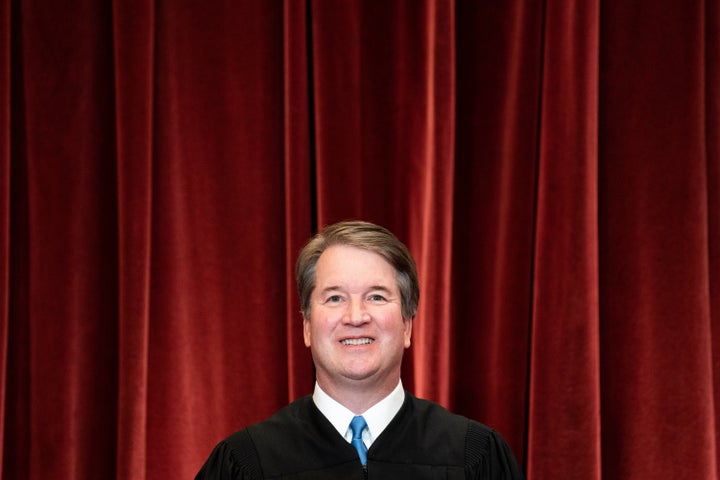The Supreme Court’s latest term has just begun, and it is set to shove one of former President Donald Trump’s appointees into the spotlight: Justice Brett Kavanaugh.
Since the court achieved its six-vote conservative supermajority in 2020, Kavanaugh has issued concurrences in high-profile decisions that provided guidance or guardrails on the majority opinions that he joined. In each case, Kavanaugh’s effort to guide future decisions and place himself at the center of the court will be tested in this term.
In this term, the court will see several cases in which they will rule on what Kavanaugh meant in three key concurrences, in which he described limits to the court’s decisions on three major topics overturning Roe v. Wade, vastly expanding gun rights and affirming Voting Rights Act precedents.
Kavanaugh’s concurrences, in theory, would limit the way these rulings can be applied to future cases. In practice, it remains to be seen if the court will stick to them.
A few upcoming cases, in particular, stand out as tests, all along similar lines to those of the last term: The dual abortion medication cases of Danco Laboratories v. Alliance for Hippocratic Medicine and Food and Drug Administration v. Alliance for Hippocratic Medicine, the gun rights case Rahimi v. U.S. and the Louisiana voting rights case Ardoin v. Robinson will greatly inform what challenges litigants are willing to bring on these issues in the future.
And they place Kavanaugh at the center of the court’s action now. That is not an unusual spot for Kavanaugh, a Trump appointee, since he barely won Senate confirmation in 2018 after being accused of committing sexual assault in high school. He has denied the allegations. In the years since, he has firmly established himself as the conservative justice most likely to join Chief Justice John Roberts in forging compromises with the court’s three liberal justices. His concurrences in two major wins for conservatives and one for liberals now put his attempt at presenting a moderate face to the test.
One of Kavanaugh’s concurrences has already been tested. In June, the court ruled in the case of Allen v. Milligan that Alabama violated the Voting Rights Act by drawing a racially discriminatory congressional map that included only one majority or plurality-Black district when demographics indicated it should have two such districts.
While Kavanaugh voted with the majority against Alabama, he also filed a separate concurrence suggesting that the ruling, upholding Section 2 of the Voting Rights Act’s limits on racially discriminatory redistricting, should not last forever. Section 2 bans the enactment of election laws and district maps that result in the “denial or abridgement of the right of any citizen of the United States to vote on account of race or color.”
Kavanaugh wrote, “[E]ven if Congress in 1982 could constitutionally authorize race-based redistricting under [Section 2] for some period of time, the authority to conduct race-based redistricting cannot extend indefinitely into the future.”

Erin Schaff-Pool/Getty Images
But, he added, “Alabama did not raise that temporal argument in this Court, and I therefore would not consider it at this time.”
This concurrence appeared to signal to future litigants that Kavanaugh was open to curtailing Section 2’s limit on racial discrimination. As Slate’s Mark Joseph Stern and Dahlia Lithwick argue, Kavanaugh was trying to copy the bat-signal style used by Justice Clarence Thomas in his dissents and concurrences as a guide for how future litigants could eventually win conservative outcomes at the court.
Thomas’ bat signals would seed future decisions years, or even decades, later, but today’s conservatives have no such patience.
So, Alabama Republicans just — disobeyed the court’s ruling in Allen and drew another congressional map with only one Black opportunity district. They seemed to believe, based on “intelligence,” that Kavanaugh supported their refusal to follow the decision he joined, according to the Alabama Political Reporter. But they were wrong. When Allen v. Milligan II reached the court, it rejected the state’s appeal and ordered it to follow a lower court ruling that mandated a court-drawn map including the two Black opportunity districts. A court adopted such a map on Thursday.
Alabama’s effort to defy the law, in keeping with its traditions of defying court orders to not racially discriminate, may have failed, but similar efforts testing Kavanaugh’s concurrence may still wind up before the court.
“We are starting to see arguments from states that are citing the concurrence as a basis for a new defense,” Sophia Lin Lakin, director of the American Civil Liberty Union’s (ACLU) Voting Rights Project, said.
Louisiana Republicans are challenging a nearly identical lower court ruling requiring the state to draw a second Black opportunity district in its congressional maps. Their current case directly cites the “temporal argument” in Kavanaugh’s concurrence to argue that Section 2’s use of race to judge discriminatory redistricting is no longer constitutional. The case is currently before a panel of judges on the Fifth Circuit Court of Appeals.
Where Kavanaugh’s concurrence in Allen gave hope to conservatives he might side with them, his concurrences in the gun rights case of New York State Rifle & Pistol Association, Inc. v. Bruen, and the ruling in Dobbs v. Jackson Women’s Health Organization provide more support to activists on the other side.
In Bruen, a majority led by Justice Clarence Thomas ruled that laws restricting gun ownership had to meet a new constitutional test by providing historical analogues from the founding period or from the ratification of the 14th Amendment. This new historical test — pegged to a time when muskets were still weapons in active use — has been interpreted by conservative lower courts in a sweeping fashion, striking down numerous previously constitutional gun restrictions.
One such challenge comes out of Texas, where Zackey Rahimi, a convicted felon and domestic abuser, is challenging his conviction for possessing a firearm while under a domestic abuse protective order. His case argues that the Bruen decision invalidates the law limiting his ability to own a gun.
The ultra-conservative judges on the Fifth Circuit Court of Appeals used Bruen to side with Rahimi: They ruled that the underlying law restricting gun ownership for people under domestic abuse orders was an “outlier that our ancestors would never have accepted” because the founding generation didn’t care about, and therefore, didn’t legislate against, domestic abuse against women. This was evidenced by the government’s inability to present a historical analogue that the 5th Circuit judges found compelling. Since there were no laws making domestic abuse illegal until 1871, let alone laws disarming abusers, the government presented bans restricting firearm ownership for classes of people, like enslaved people, Native Americans and those who refused to swear an oath of allegiance.
“These laws disarmed people thought to pose a threat to the security of the state due to their perceived lack of loyalty or societal status,” the 5th Circuit decision stated.

Nathan Howard via Getty Images
“The stakes here are potentially immense,” said Doug Letter, chief legal officer for the gun control group Brady: United Against Gun Violence. “And it’s going to depend on how broadly or narrowly the court decides to write.”
In his concurrence, which was joined by Chief Justice John Roberts, Kavanaugh suggested that Bruen did not foreclose all opportunities for gun regulation. He did so by restating the language of prior gun rights decisions in District of Columbia v. Heller and McDonald v. Chicago that the Second Amendment “is neither a regulatory straightjacket nor a regulatory blank check.”
“[N]othing in our opinion should be taken to cast doubt on longstanding prohibitions on the possession of firearms by felons and the mentally ill, or laws forbidding the carrying of firearms in sensitive places such as schools and government buildings, or laws imposing conditions and qualifications on the commercial sale of arms,” then-Justice Antonin Scalia wrote in 2008’s Heller and Kavanaugh quoted in his concurrence.
“The concurrence in Bruen obviously indicates that those justices are open to some gun regulation,” Sandra Park, an attorney with the ACLU’s Women’s Rights Project, said.
Similarly, Kavanaugh’s concurrence in Dobbs will be tested if the court takes up arguments in the twin cases of Danco Laboratories v. Alliance for Hippocratic Medicine and Food and Drug Administration v. Alliance for Hippocratic Medicine, challenging the authorization and mailing of abortion medication.
In Dobbs, Kavanaugh joined Justice Samuel Alito’s decision that overturned the constitutional right to an abortion established in Roe v. Wade and made it possible for states to ban abortion. In his decision, Alito claimed that the court was returning the issue to the states to do as they pleased. Kavanaugh went further in his concurrence: “After today’s decision, the nine Members of this Court will no longer decide the basic legality of pre-viability abortion for all 330 million Americans. That issue will be resolved by the people and their representatives in the democratic process in the States or Congress.”
But anti-abortion activists, seeking to push their advantage, continued to sue in federal court to get the justices to expand abortion bans beyond the states to apply to the whole country. They specifically targeted the Food and Drug Administration’s authorization for the use and mailing of the drug mifepristone as an abortifacient.
In April, far-right District Court Judge Matthew Kacsmaryk ruled that the FDA’s authorization for the use of mifepristone overstepped the agency’s bounds and its allowance of the drug to be acquired through the mail violated the 1873 anti-vice Comstock Act. His decision put a stay on the further mailing of the drug. The Fifth Circuit Court of Appeals upheld parts of Kacsmaryk’s decision and kept his decision to override the FDA’s drug authorization in place.
An emergency appeal to the Supreme Court resulted in a 7-2 decision temporarily that removed Kacsmaryk’s stay order, allowing the drug to continue to be used and mailed. In September, Danco Laboratories, the manufacturer of mifepristone, and the Biden administration filed briefs with the Supreme Court asking it to take up the case this term.
If it chooses to do so, Kavanaugh’s concurring opinion that “the nine Members of this Court will no longer decide the basic legality of pre-viability abortion for all 330 million Americans” will be tested. Here, anti-abortion activists are asking the court to make that decision again and to do so by both overriding the normal FDA drug approval process and resurrecting an outdated 150-year-old anti-vice law.
The decisions in all these cases are likely months in the future. But how they turn out will help determine whether some members of the court’s conservative supermajority are willing to draw a line in the sand on the hard-right tendencies of the court’s ultra-conservatives, like Thomas and Alito, and lower courts like the Fifth Circuit Court of Appeals. In doing so, it will also test Kavanaugh’s influence on the court and whether his concurrences hold any weight.

